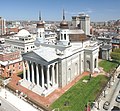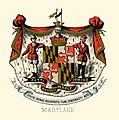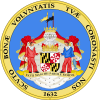Portal:Maryland
|
Maryland Portal
|
Baltimore Task Force
|
Frederick Task Force
|
Montgomery Task Force
|
WikiProject Maryland
|
|
Main page
|
Discussion
|
Introduction Maryland (US: /ˈmɛrɪlənd/ MERR-il-ənd) is a state in the Mid-Atlantic region of the United States. The state borders Virginia to its south, West Virginia to its west, Pennsylvania to its north, Delaware to its east, the Atlantic Ocean, and the national capital of Washington, D.C. With a total area of 12,407 square miles (32,130 km2), Maryland is the ninth-smallest state by land area, and its population of 6,177,224 ranks it the 18th-most populous state and the fifth-most densely populated. Maryland's capital is Annapolis, and the most populous city is Baltimore. Occasional nicknames include Old Line State, the Free State, and the Chesapeake Bay State. It is named after Henrietta Maria, the French-born queen of England, Scotland, and Ireland during the 17th century. Maryland's coastline was first explored by Europeans in the 16th century. Prior to that, it was inhabited by several Native American tribes, mostly the Algonquian peoples and, to a lesser degree, Iroquoians and Siouans. As one of the original Thirteen Colonies, Maryland was founded by George Calvert, 1st Baron Baltimore, a Catholic convert who sought to provide a religious haven for Catholics persecuted in England. In 1632, Charles I of England granted Lord Baltimore a colonial charter, naming the colony after his wife, Henrietta Maria. Unlike the Pilgrims and Puritans, Lord Baltimore envisioned a colony where people of different religious sects would coexist under the principle of toleration. In 1649, the Maryland General Assembly passed an Act Concerning Religion, which enshrined this principle by penalizing anyone who "reproached" a fellow Marylander based on religious affiliation. Nevertheless, religious strife was common in the early years, and Catholics remained a minority, albeit in greater numbers than in any other English colony. Maryland's early settlements and population centers clustered around rivers and other waterways that empty into the Chesapeake Bay. Its economy was heavily plantation-based and centered mostly on the cultivation of tobacco. Demand for cheap labor from Maryland colonists led to the importation of numerous indentured servants and enslaved Africans. In 1760, Maryland's current boundaries took form following the settlement of a long-running border dispute with Pennsylvania. Maryland was an active participant in the events leading up to the American Revolution, and by 1776, its delegates signed the Declaration of Independence. Many of its citizens subsequently played key political and military roles in the war. Although then a slave state, Maryland remained in the Union during the American Civil War, its strategic location giving it a significant role in the conflict. After the Civil War, Maryland took part in the Industrial Revolution, driven by its seaports, railroad networks, and mass immigration from Europe. Since the 1940s, the state's population has grown rapidly, to approximately six million residents, and it is among the most densely populated U.S. states. , Maryland had the highest median household income of any state, owing in large part to its proximity to Washington, D.C., and a highly diversified economy spanning manufacturing, retail services, public administration, real estate, higher education, information technology, defense contracting, health care, and biotechnology. Maryland is one of the most multicultural states in the country; it is one of the six states where non-Whites compose a majority of the population, with the fifth-highest percentage of African Americans, and high numbers of residents born in Africa, Asia, Central America, and the Caribbean. The state's central role in U.S. history is reflected by its hosting of some of the highest numbers of historic landmarks per capita. (Full article...) This is a Featured article, which represents some of the best content on English Wikipedia..
The Baltimore railroad strike of 1877 involved several days of work stoppage and violence in Baltimore, Maryland, in 1877. It formed a part of the Great Railroad Strike of 1877, during which widespread civil unrest spread nationwide following the global depression and economic downturns of the mid-1870s. Strikes broke out along the Baltimore and Ohio Railroad (B&O) on July 16, the same day that 10% wage reductions were scheduled. Violence erupted in Baltimore on July 20, with police and soldiers of the Maryland National Guard clashing with crowds of thousands gathered throughout the city. In response, President Rutherford B. Hayes ordered federal troops to Baltimore, local officials recruited 500 additional police, and two new national guard regiments were formed. Peace was restored on July 22. Between 10 and 22 were killed, more than 150 were injured, and many more were arrested. (Full article...)General imagesIn the news
On this day...The Maryland portal currently doesn't have any anniversaries listed for May 26. You can help by viewing the page source of an existing entry at /On this day to see how the entries should be formatted, then adding the missing entry. This is a Good article, an article that meets a core set of high editorial standards.
The 1886 Navy Midshipmen football team represented the United States Naval Academy in the 1886 college football season. The team marked the second time that the school played a multiple-game season. The squad was captained by halfback Clarence Stone. The year began with consecutive wins over rivals St. John's College and Johns Hopkins, but then regressed with a loss to the former and a close victory over the latter. The year concluded with shutout losses to the Princeton reserve squad and Gallaudet. The season was the program's longest until 1890, when that year's team played seven games. (Full article...) Selected article -
Adamstown is an unincorporated community and census-designated place (CDP) in Frederick County, Maryland, United States. It is named for Adam Kohlenberg (March 11, 1819 – January 1, 1868), a station agent and first town merchant who owned much of present-day Adamstown. As of the 2010 census, the Adamstown CDP had a population of 2,372. (Full article...)
Did you know?

SubcategoriesSelect [+] to view subcategories
TopicsRelated portalsAssociated WikimediaThe following Wikimedia Foundation sister projects provide more on this subject:
Discover Wikipedia using portals |























































